Category Archive 'History'
06 Mar 2025
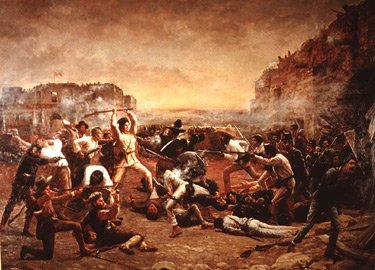
Robert Jenkins Onderdonk, Fall of the Alamo, 1903, Texas State Archives.
March 6, 1836: Following a thirteen-day siege, more than 2000 Mexican troops launched a pre-dawn attack from all four sides on the fortress defended by 180 men. The Mexicans were repulsed twice, but a third assault gained the north wall and broke through the west wall. After fierce fighting, the defenders were killed to a man. The casualties included Colonel William Barret Travis, James Bowie, and former Congressman from Tennessee David Crockett.
02 Feb 2025

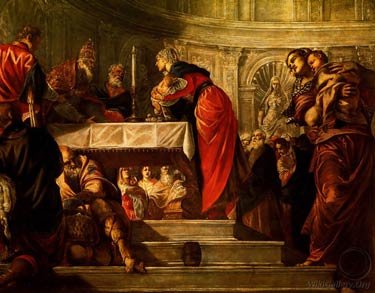
Tintoretto, Presentation of Jesus at the Temple, 1550-1555, Gallerie dell Accademi, Venice
From Robert Chambers, The Book of Days, 1869:
From a very early, indeed unknown date in the Christian history, the 2nd of February has been held as the festival of the Purification of the Virgin, and it is still a holiday of the Church of England. From the coincidence of the time with that of the Februation or purification of the people in pagan Rome, some consider this as a Christian festival engrafted upon a heathen one, in order to take advantage of the established habits of the people; but the idea is at least open to a good deal of doubt. The popular name Candlemass is derived from the ceremony which the Church of Rome dictates to be observed on this day; namely, a blessing of candles by the clergy, and a distribution of them amongst the people, by whom they are afterwards carried lighted in solemn procession. The more important observances were of course given up in England at the Reformation; but it was still, about the close of the eighteenth century, customary in some places to light up churches with candles on this day.
Read the rest of this entry »
25 Dec 2024

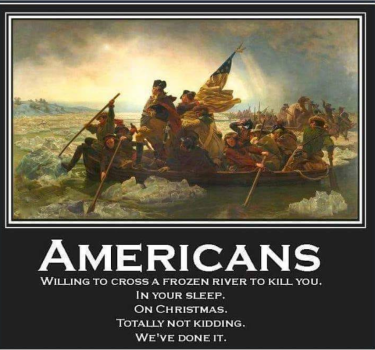
Don Surber commemorates “the Most American Christmas” of all time.
The old farmer was there with Washington when he crossed a frozen Delaware River in blizzard-like conditions on Christmas 1776. And so the photographer took a daguerreotype photo of Conrad Heyer in 1852, who 103 years early was the first European child born in Waldoboro, Maine. At 24, he had enlisted in the Continental Army and spent 1776 with Washington, whose rag-tag army went from victory in Boston to defeat in New York to a daring raid and stunning victory in the Battle of Trenton, New Jersey.
The New Market Press reported on July 25, 2013, “According to the Maine Historical Society, Heyer may be the earliest born human being ever photographed. He is also the only U.S. veteran to be photographed who crossed the Delaware River alongside George Washington in December 1776.”
There is some dispute as to whether he was the earliest born person to be photographed. Three claims of earlier birth have been made, including a slave who would have been 115 when photographed.
But there is no dispute about Heyer’s service to our country. He was a farm boy who became one of thousands of patriots who took up arms to force the best army in the world to leave the colonies so that Founding Fathers could set up a government that protected our rights.
On December 25, 1776, Heyer participated in the Most American Christmas Ever when Washington crossed the Delaware River, raided Trenton and caught 1,400 Hessian troops — who fought for the British — napping.
Heyer and the rest of the Yankee troops gathered at the river around 6 p.m. on that Christmas day for what was to be three crossings of the river. The plan was to ferry 5,400 troops and equipment but bad weather forced them to cancel the second and third crossings.
You can be darned sure that Washington was in the first crossing, along with his logistics magician Henry Knox who would serve as President Washington’s secretary of war. They named a lot of things after Knox and for good reason. He might not have been able to pull off the impossible, but the improbable was a piece of cake for him.
RTWT

Conrad Heyer in 1852, aet. 103.
25 Dec 2024


From Robert Chambers, The Book of Days, 1869:
Born: Jesus Christ, Saviour of the world; Sir Isaac Newton, natural philosopher, 1642, Woolsthorpe, near Grantham; Johann Jacob Reiske, oriental scholar, 1716, Zorbig, Saxony; William Collins, poet, 1720, Chichester; Richard Person, Greek scholar, 1759, East Ruston, Norfolk.
and my wife, Karen.
Feast Day: St. Eugenia, virgin and martyr, about 257. St. Anastasia, martyr, 304. Another St. Anastasia.
Christmas Day
The festival of Christmas is regarded as the greatest celebration throughout the ecclesiastical year, and so important and joyous a solemnity is it deemed, that a special exception is made in its favour, whereby, in the event of the anniversary falling on a Friday, that day of the week, under all other circumstances a fast, is transformed to a festival.
That the birth of Jesus Christ, the deliverer of the human race, and the mysterious link connecting the transcendent and incomprehensible attributes of Deity with human sympathies and affections, should be considered as the most glorious event that ever happened, and the most worthy of being reverently and joyously commemorated, is a pro-position which must commend itself to the heart and reason of every one of His followers, who aspires to walk in His footsteps, and share in the ineffable benefits which His death has secured to mankind. And so though at one period denounced by the Puritans as superstitious, and to the present day disregarded by Calvinistic Protestants, as unwarranted by Scripture, there are few who will seriously dispute the propriety of observing the anniversary of Christ’s birth by a religious service. … Read the rest of this entry »
23 Dec 2024


In Tablet Magazine, David Samuels
During the Trump years, Obama used the tools of the digital age to craft an entirely new type of power center for himself, one that revolved around his unique position as the titular, though pointedly never-named, head of a Democratic Party that he succeeded in refashioning in his own image—and which, after Hillary’s loss, had officially supplanted the “centrist” Clinton neoliberal machine of the 1990s. The Obama Democratic Party (ODP) was a kind of balancing mechanism between the power and money of the Silicon Valley oligarchs and their New York bankers; the interests of bureaucratic and professional elites who shuttled between the banks and tech companies and the work of bureaucratic oversight; the ODP’s own sectarian constituencies, which were divided into racial and ethnic categories like “POC,” “MENA,” and “Latinx,” whose bizarre bureaucratic nomenclature signaled their inherent existence as top-down containers for the party’s new-age spoils system; and the world of billionaire-funded NGOs that provided foot-soldiers and enforcers for the party’s efforts at social transformation.
It was the entirety of this apparatus, not just the ability to fashion clever or impactful tweets, that constituted the party’s new form of power. But control over digital platforms, and what appeared on those platforms, was a key element in signaling and exercising that power. The Hunter Biden laptop story, in which party operatives shanghaied 51 former high U.S. government intelligence and security officials to sign a letter that all but declared the laptop to be a fake, and part of a Russian disinformation plot—when most of those officials had very strong reasons to know or believe that the laptop and its contents were real—showed how the system worked. That letter was then used as the basis for restricting and banning factual reports about the laptop and its contents from digital platforms, with the implication that allowing readers to access those reports might be the basis for a future accusation of a crime. None of this censorship was official, of course: Trump was in the White House, not Obama or Biden. What that demonstrated was that the real power, including the power to control functions of the state, lay elsewhere.
Even more unusual, and alarming, was what followed Trump’s defeat in 2020. With the Democrats back in power, the new messaging apparatus could now formally include not just social and institutional pressure but the enforcement arms of the federal bureaucracy, from the Justice Department to the FBI to the SEC. As the machine ramped up, censoring dissenting opinions on everything from COVID, to DEI programs, to police conduct, to the prevalence and the effects of hormone therapies and surgeries on youth, large numbers of people began feeling pressured by an external force that they couldn’t always name; even greater numbers of people fell silent. In effect, large-scale changes in American mores and behavior were being legislated outside the familiar institutions and processes of representative democracy, through top-down social pressure machinery backed in many cases by the threat of law enforcement or federal action, in what soon became known as a “whole of society” effort.
At every turn over the next four years, it was like a fever was spreading, and no one was immune. Spouses, children, colleagues, and supervisors at work began reciting, with the force of true believers, slogans they had only learned last week, and that they were very often powerless to provide the slightest real-world evidence for. These sudden, sometimes overnight, appearances of beliefs, phrases, tics, looked a lot like the mass social contagions of the 1950s—one episode after another of rapid-onset political enlightenment replacing the appearance of dance crazes or Hula-Hoops.
During the Trump years, Obama used the tools of the digital age to craft an entirely new type of power center for himself, one that revolved around his unique position as the titular, though pointedly never-named, head of a Democratic Party that he succeeded in refashioning in his own image.
Just as in those commercially fed crazes, there was nothing accidental, mystical or organic about these new thought-viruses. Catchphrases like “defund the police,” “structural racism,” “white privilege,” “children don’t belong in cages,” “assigned gender” or “stop the genocide in Gaza” would emerge and marinate in meme-generating pools like the academy or activist organizations, and then jump the fence—or be fed—into niche groups and threads on Twitter or Reddit. If they gained traction in those spaces, they would be adopted by constituencies and players higher up in the Democratic Party hierarchy, who used their control of larger messaging verticals on social media platforms to advance or suppress stories around these topics and phrases, and who would then treat these formerly fringe positions as public markers for what all “decent people” must universally believe; those who objected or stood in the way were portrayed as troglodytes and bigots. From there, causes could be messaged into reality by state and federal bureaucrats, NGOs, and large corporations, who flew banners, put signs on their bathrooms, gave new days off from work, and brought in freshly minted consultants to provide “trainings” for workers—all without any kind of formal legislative process or vote or backing by any significant number of voters.
What mattered here was no longer Lippmann’s version of “public opinion,” rooted in the mass audiences of radio and later television, which was assumed to correlate to the current or future preferences of large numbers of voters—thereby assuring, on a metaphoric level at least, the continuation of 19th-century ideas of American democracy, with its deliberate balance of popular and representational elements in turn mirroring the thrust of the Founders’ design. Rather, the newly minted digital variant of “public opinion” was rooted in the algorithms that determine how fads spread on social media, in which mass multiplied by speed equals momentum—speed being the key variable. The result was a fast-moving mirror world that necessarily privileges the opinions and beliefs of the self-appointed vanguard who control the machinery, and could therefore generate the velocity required to change the appearance of “what people believe” overnight.
The unspoken agreements that obscured the way this social messaging apparatus worked—including Obama’s role in directing the entire system from above—and how it came to supplant the normal relationships between public opinion and legislative process that generations of Americans had learned from their 20th-century poli-sci textbooks, made it easy to dismiss anyone who suggested that Joe Biden was visibly senile; that the American system of government, including its constitutional protections for individual liberties and its historical system of checks and balances, was going off the rails; that there was something visibly unhealthy about the merger of monopoly tech companies and national security agencies with the press that threatened the ability of Americans to speak and think freely; or that America’s large cultural systems, from education, to science and medicine, to the production of movies and books, were all visibly failing, as they fell under the control of this new apparatus. Millions of Americans began feeling increasingly exhausted by the effort involved in maintaining parallel thought-worlds in which they expressed degrees of fealty to the new order in the hope of keeping their jobs and avoiding being singled out for ostracism and punishment, while at the same time being privately baffled or aghast by the absence of any persuasive logic behind the changes they saw—from the breakdown of law and order in major cities, to the fentanyl epidemic, to the surge of perhaps 20 million unvetted illegal immigrants across the U.S. border, to widespread gender dysphoria among teenage girls, to sudden and shocking declines in public health, life expectancy, and birth rates.
Until the fever broke. Today, Donald Trump is victorious, and Obama is the loser.
RTWT — This one’s a must-read essay.
06 Dec 2024


St. Nicholas, bishop of Myra, d. 6 December 345 or 352
St. Nicholas was reportedly born in the city of Patara in Lycia in Asia Minor, heir to a wealthy family. He succeeded an uncle as bishop of Myra.
Nicholas left behind a legend of secret acts of benevolence and miracles (in Greek, he is spoken of as “Nikolaos o Thaumaturgos” — Nicholas the Wonder-Worker).
One of the saint’s prominent legends asserts that, in a time of famine, he foiled the crime of Fourth Century Sweeney Todd, an evil butcher who kidnapped and murdered three children, intending to market their remains as ham. St. Nicholas not only exposed the murder, but healed and resurrected the children intact.
Nicholas is also renowned for providing dowries for each of three daughters of an impoverished nobleman,who would otherwise have been unable to marry and who were about to be forced to prostitute themselves to live. In order to spare the sensibilities of the family, Nicholas is said to have secretly thrown a purse of gold coins into their window on each of three consecutive nights.
St. Nicholas’ covert acts of charity led to a custom of the giving of secret gifts concealed in shoes deliberately left out for their receipt on his feast day, and ultimately to the contemporary legend of Santa Claus leaving gifts in stockings on Christmas Eve.
St. Nicholas evolved into one of the most popular saints in the Church’s calendar, serving as patron of sailors, merchants, archers, thieves, prostitutes, pawnbrokers, children, and students, Greeks, Belgians, Frenchmen, Romanians, Bulgarians, Georgians, Albanians, Russians, Macedonians, Slovakians, Serbians, and Montenegrins, and all residents of Aberdeen, Amsterdam, Barranquilla, Campen, Corfu, Freiburg, Liverpool, Lorraine, Moscow, and New Amsterdam (New York).
His relics were stolen and removed to Bari to prevent capture by the Turks, and are alleged to exude a sweet-smelling oil down to the present day.
28 Nov 2024

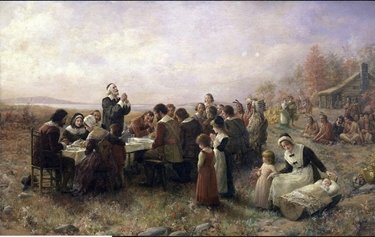
Mike Franc, at Human Events in 2005, identified the real reason for celebration at the first Thanksgiving.
Writing in his diary of the dire economic straits and self-destructive behavior that consumed his fellow Puritans shortly after their arrival, Governor William Bradford painted a picture of destitute settlers selling their clothes and bed coverings for food while others “became servants to the Indians,” cutting wood and fetching water in exchange for “a capful of corn.” The most desperate among them starved, with Bradford recounting how one settler, in gathering shellfish along the shore, “was so weak– he stuck fast in the mud and was found dead in the place.”
The colony’s leaders identified the source of their problem as a particularly vile form of what Bradford called “communism.’ Property in Plymouth Colony, he observed, was communally owned and cultivated. This system (“taking away of property and bringing [it] into a commonwealth’) bred “confusion and discontent” and “retarded much employment that would have been to [the settlers’] benefit and comfort.”
Just how did the Pilgrims solve the problem of famine? In addition to receiving help from the local Indians in farming, they decided allow the private ownership of individual plots of land.
On the brink of extermination, the Colony’s leaders changed course and allotted a parcel of land to each settler, hoping the private ownership of farmland would encourage self-sufficiency and lead to the cultivation of more corn and other foodstuffs.
As Adam Smith would have predicted, this new system worked famously. “This had very good success,” Bradford reported, ‘for it made all hands very industrious.” In fact, “much more corn was planted than otherwise would have been” and productivity increased. “Women,” for example, “went willingly into the field, and took their little ones with them to set corn.”
The famine that nearly wiped out the Pilgrims in 1623 gave way to a period of agricultural abundance that enabled the Massachusetts settlers to set down permanent roots in the New World, prosper, and play an indispensable role in the ultimate success of the American experiment.
A profoundly religious man, Bradford saw the hand of God in the Pilgrims’ economic recovery. Their success, he observed, “may well evince the vanity of that conceit–that the taking away of property– would make [men] happy and flourishing; as if they were wiser than God.’ Bradford surmised, ‘God in his wisdom saw another course fitter for them.”
The real story of Thanksgiving is the triumph of capitalism and individualism over collectivism and socialism, which is the summation of the story of America.
28 Nov 2024

As published in the Massachusetts Centinel, Wednesday, October 14, 1789
12 Oct 2024


Christopher Columbus (detail), from Alejo Fernández, La Virgen de los Navegantes, circa 1505 to 1536, Alcázares Reales de Sevilla.
In his magisterial biography, Admiral of the Ocean Sea, 1942, Samuel Elliot Morrison observes:
[Christopher Columbus did] more to direct the course of history than any individual since Augustus Caesar. …
The voyage that took him to “The Indies” and home was no blind chance, but the creation of his own brain and soul, long studied, carefully planned, repeatedly urged on indifferent princes, and carried through by virtue of his courage, sea-knowledge and indomitable will. No later voyage could ever have such spectacular results, and Columbus’s fame would have been secure had he retired from the sea in 1493. Yet a lofty ambition to explore further, to organize the territories won for Castile, and to complete the circuit of the globe, sent him thrice more to America. These voyages, even more than the first, proved him to be the greatest navigator of his age, and enabled him to train the captains and pilots who were to display the banners of Spain off every American cape and island between Fifty North and Fifty South. The ease with which he dissipated the unknown terrors of the Ocean, the skill with which he found his way out and home, again and again, led thousands of men from every Western European nation into maritime adventure and exploration.
The whole history of the Americas stem from the Four Voyages of Columbus; and as the Greek city-states looked back to the deathless gods as their founders, so today a score of independent nations and dominions unite in homage to Christopher the stout-hearted son of Genoa, who carried Christian civilization across the Ocean Sea.
An annual post.
11 Sep 2024


Captain Rescorla in action at Ia Drang, Republic of Vietnam, 15 November 1965.
photograph: Peter Arnett/AP.
Born in Hayle, Cornwall, May 27, 1939, to a working-class family, Rescorla joined the British Army in 1957, serving three years in Cyprus. Still eager for adventure, after army service, Rescorla enlisted in the Northern Rhodesia Police.
Ultimately finding few prospects for advancement in Britain or her few remaining colonies, Rescorla moved to the United States, and joined the US Army in 1963. After graduating from Officers’ Candidate School at Fort Benning, Georgia in 1964, he was assigned as a platoon leader to Bravo Company of the 2nd Battalion, 7th Cavalry, Third Brigade of the 1st Cavalry Division (Airmobile). Rescorla’s serious approach to training and his commitment to excellence led to his men to apply to him the nickname “Hard Corps.”
The 2nd Battalion of the 7th Cavalry was sent to Vietnam in 1965, where it soon engaged in the first major battle between American forces and the North Vietnamese Army at Ia Drang.
The photograph above was used on the cover of Colonel Harold Moore’s 1992 memoir We Were Soldiers Once… and Young, made into a film starring Mel Gibson in 2002. Rescorla was omitted from the cast of characters in the film, which nonetheless made prominent use of his actual exploits, including the capture of the French bugle and the elimination of a North Vietnamese machine gun using a grenade.
For his actions in Vietnam, Rescorla was awarded the Silver Star, the Bronze Star (twice), the Purple Heart, and the Vietnamese Cross of Gallantry. After Vietnam, he continued to serve in the Army Reserve, rising to the rank of Colonel by the time of his retirement in 1990.
Rick Rescorla became a US citizen in 1967. He subsequently earned bachelor’s, master’s, and law degrees from the University of Oklahoma, and proceeded to teach criminal law at the University of South Carolina from 1972-1976, before he moved to Chicago to become Director of Security for Continental Illinois Bank and Trust.
In 1985, Rescorla moved to New York to become Director of Security for Dean Witter, supervising a staff of 200 protecting 40 floors in the South Tower of the World Trade Center. (Morgan Stanley and Dean Witter merged in 1997.) Rescorla produced a report addressed to New York’s Port Authority identifying the vulnerability of the Tower’s central load-bearing columns to attacks from the complex’s insecure underground levels, used for parking and deliveries. It was ignored.
On February 26, 1993, Islamic terrorists detonated a car bomb in the underground garage located below the North Tower. Six people were killed, and over a thousand injured. Rescorla took personal charge of the evacuation, and got everyone out of the building. After a final sweep to make certain that no one was left behind, Rick Rescorla was the last to step outside.
—————————————-
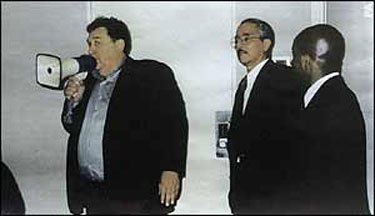
Directing the evacuation on September 11th.
Security Guards Jorge Velasquez and Godwin Forde are on the right.
photograph: Eileen Mayer Hillock.
Rescorla was 62 years old, and suffering from prostate cancer on September 11, 2001. Nonetheless, he successfully evacuated all but 6 of Morgan Stanley’s 2800 employees. (Four of the six lost included Rescorla himself and three members of his own security staff, including both the two security guards who appear in the above photo and Vice President of Corporate Security Wesley Mercer, Rescorla’s deputy.) Rescorla travelled personally, bullhorn in hand, as low as the 10th floor and as high as the 78th floor, encouraging people to stay calm and make their way down the stairs in an orderly fashion. He is reported by many witnesses to have sung “God Bless America,” “Men of Harlech, ” and favorites from Gilbert & Sullivan operettas. “Today is a day to be proud to be an American,” he told evacuees.
A substantial portion of the South Tower’s workforce had already gotten out, thanks to Rescorla’s efforts, by the time the second plane, United Airlines Flight 175, struck the South Tower at 9:02:59 AM. Just under an hour later, as the stream of evacuees came to an end, Rescorla called his best friend Daniel Hill on his cell phone, and told him that he was going to make a final sweep. Then the South Tower collapsed.
Rescorla had observed a few months earlier to Hill, “Men like us shouldn’t go out like this.” (Referring to his cancer.) “We’re supposed to die in some desperate battle performing great deeds.” And he did.
—————————————-
His hometown of Hayle in Cornwall has erected a memorial.

—————————————-
2,996 was a project put together by blogger Dale Roe to honor each victim of the September 11, 2001 attacks. 3,061 blogs committed to posting tributes to each victim. Never Yet Melted’s tribute was to Rick Rescorla, and is republished annually>
04 Jul 2024


About the Declaration there is a finality that is exceedingly restful. It is often asserted that the world has made a great deal of progress since 1776, that we have had new thoughts and new experiences which have given us a great advance over the people of that day, and that we may therefore very well discard their conclusions for something more modern. But that reasoning can not be applied to this great charter. If all men are created equal, that is final. If they are endowed with inalienable rights, that is final. If governments derive their just powers from the consent of the governed, that is final. No advance, no progress can be made beyond these propositions. If anyone wishes to deny their truth or their soundness, the only direction in which he can proceed historically is not forward, but backward toward the time when there was no equality, no rights of the individual, no rule of the people. Those who wish to proceed in that direction can not lay claim to progress. They are reactionary. Their ideas are not more modern, but more ancient, than those of the Revolutionary fathers.
–Calvin Coolidge
/div>

Feeds
|

















